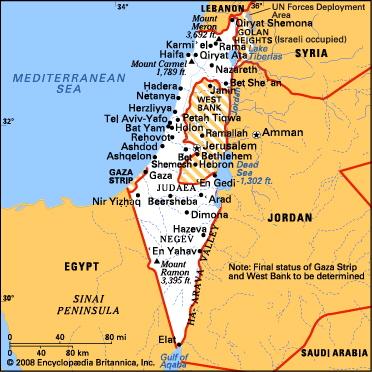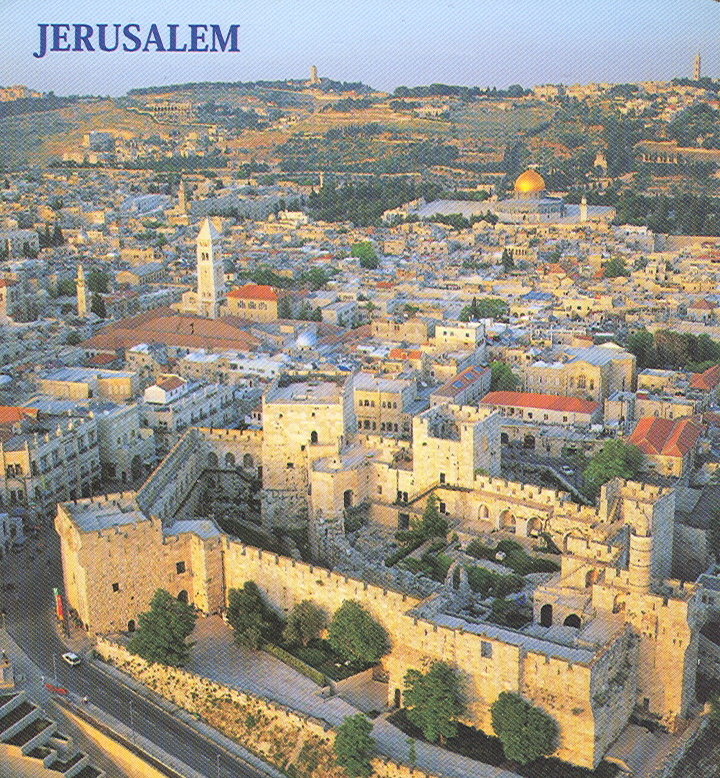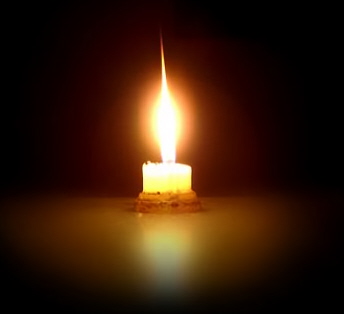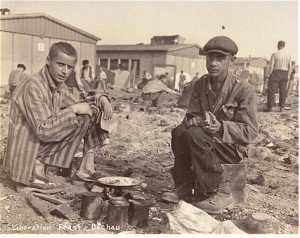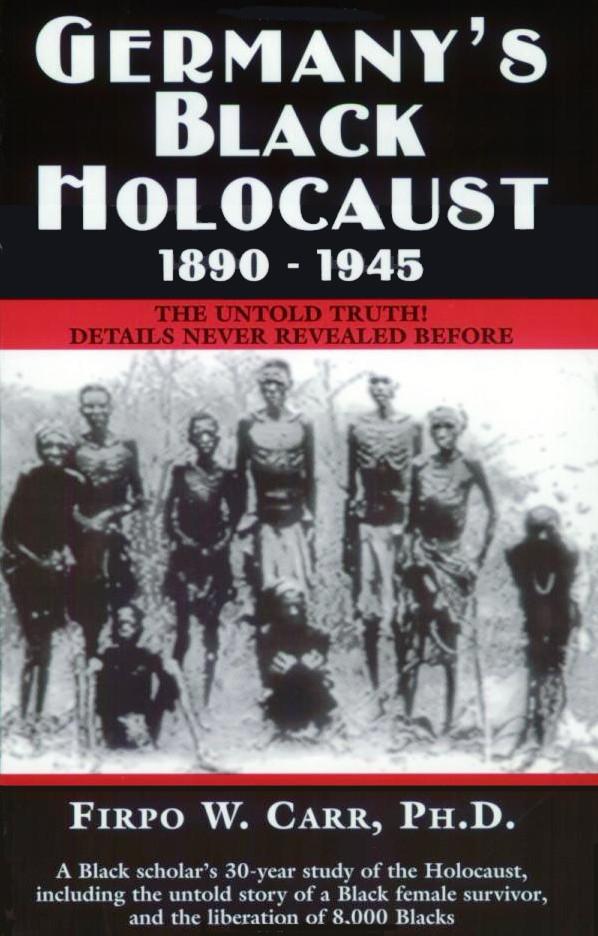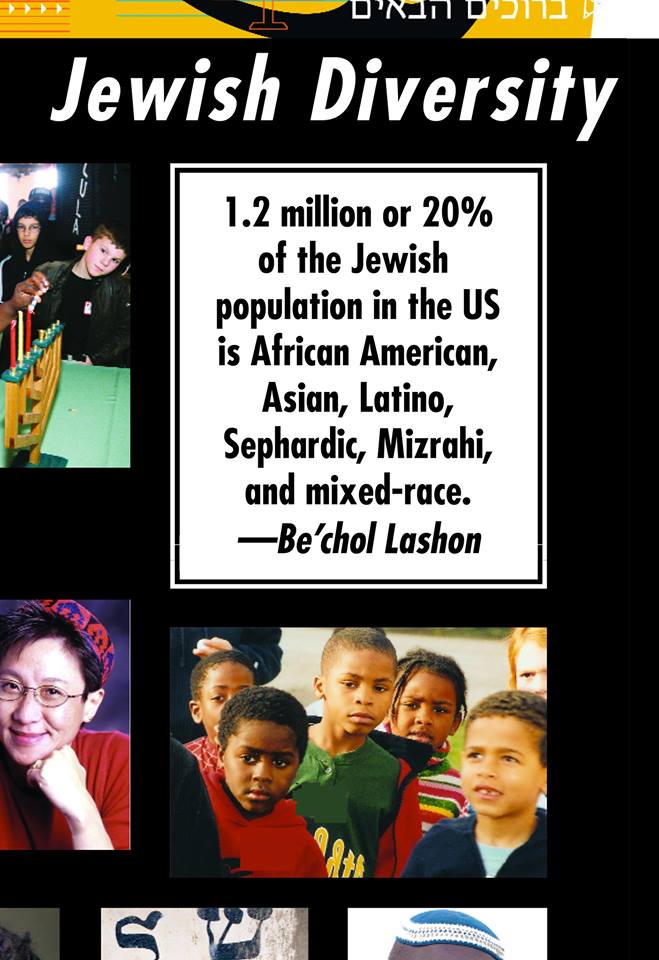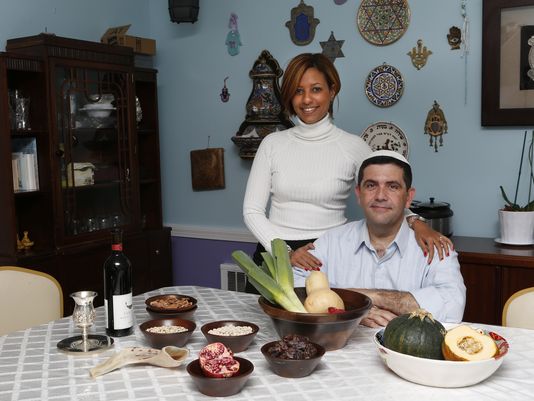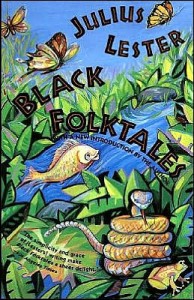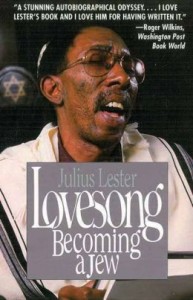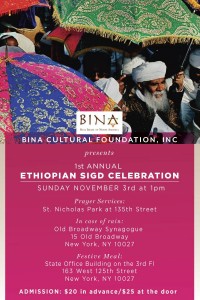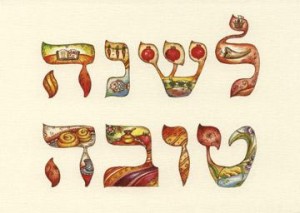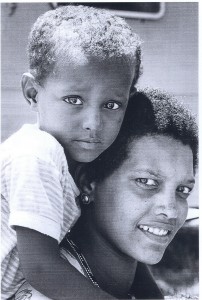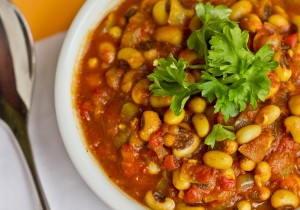All over the world, Am Yisrael Chai,
All over the world, Am Yisrael Chai,
All over the world, is where we live
and Israel lives in every Jewish heart.
From North and South and East and
West to you we say Shalom, yet
always we know Israel is our home
away from home.
Ethiopian Jews in Israel – Jet Magazine Mar 31, 1955
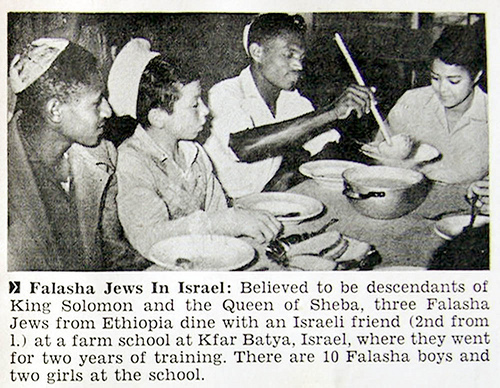 Photo courtesy of Vieilles_annonces of Flickr
Photo courtesy of Vieilles_annonces of Flickr
For 1500 years, Beta Israel held onto their Jewish traditions in Ethiopia, praying on the Sigd holiday to one day return to Jerusalem.
Tzvat (Safed) is one of the oldest towns in Israel, situated on mountain tops in the Upper Gallile, since the era of the 2nd Temple. It the center for Kabbalah scholars.
The history of the exile of the lost tribe of Menashe dates back over 2500 years. Hundreds of descendants believe they have found their ancient home in Samaria.
“He (Menashe) also will become a people, and he also will be great. However, his younger brother (Ephraim) will be greater than he, and his descendants (B’nei Efrayim) will become a multitude of nations. He blessed them that day, saying, ‘In you will Israel bless, saying, ‘G-d make you as Ephraim and as Menashe.’ He set Ephraim before Menashe” (Bereishit 48:19-20).
Israelis Wear Loks
Just near the Carmel Market on the Nahalat Binyamin pedestrian walk. Arts & Crafts Fair on Tuesdays and Fridays when the artists themselves are offering their creations. Chantal, Nahalat Binymin Art & Crafts Fair. Tel Aviv
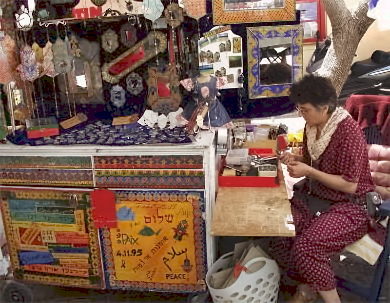
Hanging Hand painted Glass by Chantal

“The duty of the survivor is to bear testimony to what happened … You have to warn people that these things can happen, that evil can be unleashed. Race hatred, violence, idolatries — they still flourish.” — Elie Wiesel
The United States Congress established the Days of Remembrance as the nation’s annual commemoration of the Holocaust and created the United States Holocaust Memorial Museum as a permanent living memorial to the victims. Days of Remembrance 2015 Events
The Blessing of the Yellow Candle
We light the yellow candle to rekindle God’s flame,
to shine His light upon the world once again,
to sanctify the memories of millions of souls,
to honor their prayers and all their lost goals,
we bless their existence by being alive,
to light this yellow candle as proof we survived.
~By Ron Adler
“Who Am I To Speak Of A Time?”
Who am I to speak of a time,
of families crushed, of crimes of mankind,
of children in hiding and living in fear,
of mothers trying to hide all their tears,
of fathers praying to an empty heaven,
of people dying again and again?
Who am I to know what it was like
to be persecuted by day and trapped by the night,
to be surrounded by a world turned upside down,
to be starved and tortured and beaten to the ground,
to witness a nation of hate marching past,
to see all their dreams broken and shattered like glass?
Who am I to mention their suffering and pain,
the ghettos, the camps, life and death inhumane?
I wasn’t even born, I wasn’t even there,
it happened long ago, it could never happen here.
Who am I to know what God had in mind
when the virtues of man were buried alive,
when good lost to evil and hope turned to despair,
when hell upon earth seemed everywhere?
Who am I to let their memories be forgotten,
to say and do nothing as if it never happened,
to forsake the loss of our Jewish family,
to live in a world of complacency?
____________________________________
1.5 million innocent children perished in the Holocaust. In an effort to remember them, Holocaust Museum Houston is collecting 1.5 million handmade butterflies. The butterflies will eventually comprise a breath-taking exhibition, currently scheduled for Spring 2013, for all to remember. Learn how you can help at http://www.hmh.org/ed_butterfly1.shtml.
Sam Glaser • A Million Butterflies, about the children of the Holocaust
Educator Leon Bass, January 23, 1935 – March 28, 2015. Former Principal of Benjamin Franklin High School, Philadelphia, PA witnessed Buchenwald concentration camp shortly after its liberation. Read Article: Leon Bass, 90, educator forever changed by the Holocaust
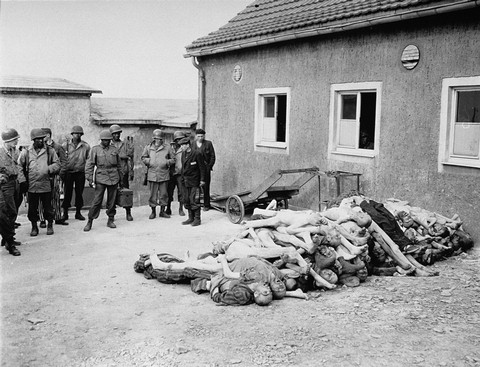
American troops, including African American soldiers from the Headquarters and Service Company of the 183rd Engineer Combat Battalion, 8th Corps, U.S. 3rd Army, view corpses stacked behind the crematorium during an inspection tour of the Buchenwald concentration camp. Among those pictured is Leon Bass (the soldier third from left). Buchenwald, Germany, April 17, 1945.
At the rising of the sun and at its going down
We remember them.
At the blowing of the wind and in the chill of winter
We remember them.
At the opening of the buds and in the rebirth of spring
We remember them.
At the blueness of the skies and in the warmth of summer
We remember them.
At the rustling of the leaves and in the beauty of autumn
We remember them.
At the beginning of the year and when it ends
We remember them.
As long as we live, they too will live;
for they are now a part of us
as we remember them.
Ani Ma’amin by Lynette, Ben Sidran: Life’s a Lesson
Blacks During the Holocaust
The fate of black people from 1933 to 1945 in Nazi Germany and in German-occupied territories ranged from isolation to persecution, sterilization, medical experimentation, incarceration, brutality, and murder.
Two survivors prepare food outside the barracks. On the right is presumably Jean (Johnny) Voste, born in Belgian Congo, was the only black prisoner in Dachau.
There but for the grace of God, go I…
Remember the Afro-German Rhineland Children
Underscoring Hitler’s obsession with racial purity, by 1937, every identified mixed-race child in the Rhineland had been forcibly sterilized, in order to prevent further “race polluting”, as Hitler termed it.
The fate of black people from 1933 to 1945 in Nazi Germany and in German-occupied territories ranged from isolation to persecution, sterilization, medical experimentation, incarceration, brutality, and murder. However, there was no systematic program for their elimination as there was for Jews and other groups.
If you are like most people, you simply have never heard the unbelievable story of Black victims of the Holocaust. You are invited to read about the human spirit’s triump over events that occurred during this horrible piece of hidden history.
After World War I, the Allies stripped Germany of its African colonies. The German military stationed in Africa (Schutztruppen), as well as missionaries, colonial bureaucrats, and settlers, returned to Germany and took with them their racist attitudes. Separation of whites and blacks was mandated by the Reichstag (German parliament), which enacted a law against mixed marriages in the African colonies.
Following World War I and the Treaty of Versailles (1919), the victorious Allies occupied the Rhineland in western Germany. The use of French colonial troops, some of whom were black, in these occupation forces exacerbated anti-black racism in Germany. Racist propaganda against black soldiers depicted them as rapists of German women and carriers of venereal and other diseases. The children of black soldiers and German women were called “Rhineland Bastards.” The Nazis, at the time a small political movement, viewed them as a threat to the purity of the Germanic race. In Mein Kampf (My Struggle), Hitler charged that “the Jews had brought the Negroes into the Rhineland with the clear aim of ruining the hated white race by the necessarily-resulting bastardization.”
African German mulatto children were marginalized in German society, isolated socially and economically, and not allowed to attend university. Racial discrimination prohibited them from seeking most jobs, including service in the military. With the Nazi rise to power they became a target of racial and population policy. By 1937, the Gestapo (German secret state police) had secretly rounded up and forcibly sterilized many of them. Some were subjected to medical experiments; others mysteriously “disappeared.”
The racist nature of Adolf Hitler’s regime was disguised briefly during the Olympic Games in Berlin in August 1936, when Hitler allowed 18 African American athletes to compete for the U.S. team. However, permission to compete was granted by the International Olympic Committee and not by the host country.
Adult African Germans were also victims. Both before and after World War I, many Africans came to Germany as students, artisans, entertainers, former soldiers, or low-level colonial officials, such as tax collectors, who had worked for the imperial colonial government. Hilarius (Lari) Gilges, a dancer by profession, was murdered by the SS in 1933, probably because he was black. Gilges’ German wife later received restitution from a postwar German government for his murder by the Nazis.
Some African Americans, caught in German-occupied Europe during World War II, also became victims of the Nazi regime. Many, like female jazz artist Valaida Snow, were imprisoned in Axis internment camps for alien nationals. The artist Josef Nassy, living in Belgium, was arrested as an enemy alien and held for seven months in the Beverloo transit camp in German-occupied Belgium. He was later transferred to Germany, where he spent the rest of the war in the Laufen internment camp and its subcamp, Tittmoning, both in Upper Bavaria.
European and American blacks were also interned in the Nazi concentration camp system. Lionel Romney, a sailor in the U.S. Merchant Marine, was imprisoned in the Mauthausen concentration camp. Jean Marcel Nicolas, a Haitian national, was incarcerated in the Buchenwald and Dora-Mittelbau concentration camps in Germany. Jean Voste, an African Belgian, was incarcerated in the Dachau concentration camp. Bayume Mohamed Hussein from Tanganyika (today Tanzania) died in the Sachsenhausen camp, near Berlin.
Black prisoners of war faced illegal incarceration and mistreatment at the hands of the Nazis, who did not uphold the regulations imposed by the Geneva Convention (international agreement on the conduct of war and the treatment of wounded and captured soldiers). Lieutenant Darwin Nichols, an African American pilot, was incarcerated in a Gestapo prison in Butzbach. Black soldiers of the American, French, and British armies were worked to death on construction projects or died as a result of mistreatment in concentration or prisoner-of-war camps. Others were never even incarcerated, but were instead immediately killed by the SS or Gestapo.
Some African American members of the U.S. Armed forces were liberators and witnesses to Nazi atrocities. The 761st Tank Battalion (an all-African American tank unit), attached to the 71st Infantry Division, U.S. Third Army, under the command of General George Patton, participated in the liberation of Gunskirchen, a subcamp of the Mauthausen concentration camp, in May 1945.
NEVER AGAIN must remain more than a mere slogan
Rabbi Rigoberto Emmanuel Viñas and his wife Sandra Viñas are a newly wed Cuban and Dominican couple that put a latin twist on some of the traditional Jewish dishes for the holiday. Rabbi Rigoberto Emmanuel and Sandra Viñas are photographed with some of the symbolic foods they will eat for Rosh Hashanah, Sept. 12, 2014 in their Yonkers home.(Photo: Tania Savayan/The Journal News)
During Rosh Hashana, the Jewish New Year, food is as central to the celebration as prayer. But the kosher meal on the table of one Yonkers family will have a unique flavor: Latin.
Sephardic Rabbi Rigoberto Emmanuel “Manny” Viñas and his wife, Sandra Nuñez Viñas, have planned a menu that includes Pan de Calabaza (pumpkin bread), Keftes de Prasa (leek and scallion croquettes), Lubiya (black eyed peas) and La Sopa de las Siete Verduras (seven vegetable soup with stew meat).
“My wife, Sandra, is Dominican, so we jokingly call her Jew-minican,” he laughs. “She has a challah recipe, and she’ll put coconut oil instead of regular oil. That will add a little bit of sweetness so that it will be a sweet year.”
As the founder and director of El Centro de Estudios Judíos “Torat Emet,” a Spanish-language Jewish education and spirituality center for Latin American Jews living in the New York area, Rabbi Viñas has a growing contingent of followers. The internet broadcasts of his lectures have brought an international audience to the Spanish Torah.
“It’s Judaism with a little Latin flavor,” says Viñas.
For the coming Rosh Hashana celebration, he and his wife will be joined in by more than 20 members of the Lincoln Park Jewish Center for a traditional meal, and plenty of song, stories and wine.
“We’ll probably have five languages at the table,” he says.
Working with his mother’s original recipes, saved on a handwritten and wine-stained paper from years of use, they will prepare a kosher meal that features some typical items found in Latin cooking, like coconut oil and fried plantains.
“My family left Cuba and I grew up in Miami, and attended primarily Spanish speaking synagogues,” says Viñas. “She sent me these recipes when I moved to New York.”
Each prayer — said in both Aramaic and Ladino, sometimes called Judeo-Spanish — will be accompanied by a dish that signifies desires for the new year, such as black-eyed peas for prosperity or fish for fertility. And guests will enjoy Yarden Mount Hermon red wine from Golan Heights in Israel with the main course. “It pairs really well with the seven vegetable stew.”
“The pomegranate has 613 seeds, so in eating it you’re saying ‘I should have as much prosperity as I have seeds’,” Viñas explains. “And eating it brings the prayer to completion.”
Twitter: @megmccaff15
Rabbi Viñas is the founder and director of El Centro de Estudios Judíos “Torat Emet,” a Spanish-language Jewish education and spirituality center for Latin-American Jews living in the New York area. Visit lpjc.org for more information.
(originally posted here.)
“Shalom, Mirembe!”
The Abayudaya Jewish Community of Uganda and Israeli artist Irene Orleansky partnered to create “Shalom, Mirembe!” as part of a music collection from Israelites and Jews of Africa and Asia. For more information and to purchase the CD visit www.ireneorleanskyo.com The participating Jewish communities receive all proceeds from CD sales.
Lead singers – Irene Orleansky, J.J. Keki, and Rachman Nagwere
Dance – Hope Cultural Troupe
Drums – Jerry Marotta
Mix – Kirill Malahov at Music Brothers Records
Mastering – Donal Whelan at Mastering World Studios
Video – Hannah Nemer
Back vocals — Rachel Nagudi, Irene Orleansky, David Kababala, Rachman Nagwere, J.J. Keki
Stick — Irene Orleansky
Xylophone — Sula Gidenyi, Ali Walufu
African drums — Amram Kadosi, Joshua Adjah Anang,
African percussion – Joshua Adjah Anang, Irene Orleansky
New CD Release: Music of Israelites and Jews of Africa and Asia
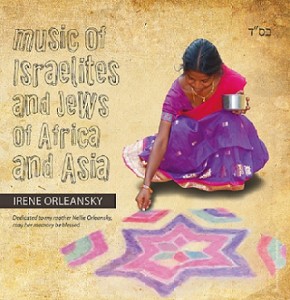 The CD Music of Israelites and Jews of Africa and Asia is the result of Irene Orleansky’s fascinating two-year journey through Africa and Asia. Equipped with a mobile studio, Irene visited nine Israelite and Jewish communities sometimes at distant and dangerous places to record music with the communities’ artists.
The CD Music of Israelites and Jews of Africa and Asia is the result of Irene Orleansky’s fascinating two-year journey through Africa and Asia. Equipped with a mobile studio, Irene visited nine Israelite and Jewish communities sometimes at distant and dangerous places to record music with the communities’ artists.
The story of the lost tribes started in the 7th century BC in the lands of Aramea and the Kingdom of Israel when the Assyrians invaded the Northern lands and deported ten Israelite tribes of the Northern Kingdom, thus starting the longest exile in the history of mankind. For many centuries those tribes were considered lost, until the last centuries, when technological developments in transport and communication revealed what had been previously hidden.
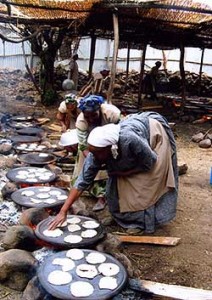 The Ethiopian Jews of the tribe of Dan made an epic return when Israel airlifted them in Operation Moses in 1984 and Operation Solomon in 1991; Bene Israel of India, supposedly of the tribe of Zebulon, returned to Israel between 1948 and 1969. Right now thousands of Bnei Menashe are coming back home from North-Eastern India and Burma. Still there are thousands of descendants of the lost tribes of Israel who remain in the lands of their exile and thousands more to be rediscovered yet. In her journey, Irene was privileged to witness and actively participate in fulfilling the Biblical prophecy, the return of the lost tribes of Israel, and to discover unique music and culture of her long lost brothers and sisters.
The Ethiopian Jews of the tribe of Dan made an epic return when Israel airlifted them in Operation Moses in 1984 and Operation Solomon in 1991; Bene Israel of India, supposedly of the tribe of Zebulon, returned to Israel between 1948 and 1969. Right now thousands of Bnei Menashe are coming back home from North-Eastern India and Burma. Still there are thousands of descendants of the lost tribes of Israel who remain in the lands of their exile and thousands more to be rediscovered yet. In her journey, Irene was privileged to witness and actively participate in fulfilling the Biblical prophecy, the return of the lost tribes of Israel, and to discover unique music and culture of her long lost brothers and sisters.
While traveling, Irene saw hardship, poverty and discrimination that many of the Jewish communities in Africa and Asia encounter in their daily lives, and decided to turn it into a charity project to raise funds to support those communities in need.
All the money earned from the sales of the album will be spread among the communities to support their music and arts. By buying the CD, you are supporting the Jewish and Israelite communities in Africa and Asia. PURCHASE HERE!
Julius Lester – African American Jewish Author, Poet, Photographer, Musician, Songwriter, Activist & More
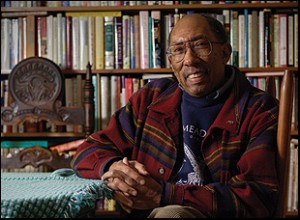 Julius Lester was born January 27, 1939 in St. Louis, Missouri, the son of a Methodist minister. Lester spent much of his childhood in Missouri, where in the 1940s and 1950s he dealt with southern attitudes about race and segregation before and during the Civil Rights movement. In 1960 Lester graduated from Fisk University in Nashville, Tennessee with a degree in English.
Julius Lester was born January 27, 1939 in St. Louis, Missouri, the son of a Methodist minister. Lester spent much of his childhood in Missouri, where in the 1940s and 1950s he dealt with southern attitudes about race and segregation before and during the Civil Rights movement. In 1960 Lester graduated from Fisk University in Nashville, Tennessee with a degree in English.
He then became politically active in the Civil Rights movement, going to Mississippi in 1964 as part of the movement called the Mississippi Summer Project. Lester then began working full time for the Student Nonviolent Coordinating Committee (SNCC) as head of its photography department in Atlanta, Georgia. SNCC was the most outspoken of civil rights groups at the time, and in the summer of 1966 coined the phrase black power, a cry millions of blacks across the United States responded to and adapted as their own.
 Lester’s writing career began in 1967 when a publisher read his essay The Angry Children of Malcolm X, and offered him a contract to develop it into a book. The book, titled Look Out, Whitey! Black Power’s Gonna’ Get Your Mama, was published in 1968, and would be the first book to explain the term black power and place it in the context of African American history.
Lester’s writing career began in 1967 when a publisher read his essay The Angry Children of Malcolm X, and offered him a contract to develop it into a book. The book, titled Look Out, Whitey! Black Power’s Gonna’ Get Your Mama, was published in 1968, and would be the first book to explain the term black power and place it in the context of African American history.
Since 1968 Lester has published thirty-four books, including non-fiction, children’s books, poetry, and novels. Among the awards these books have received are the Newbery Honor Medal, the Lewis Carroll Shelf Award, National Book Award Finalist, Boston Globe/Horn Book Award, National Book Critics Circle Honor Book, and New York Times Outstanding Book. His books have also been translated into eight languages.
As a child Lester learned that his maternal great-grandfather was a German Jew named Adolph Altschul who had immigrated from Germany sometime before the Civil War. He met a fair-skinned ex-slave named Maggie Carson and they had six children together one of whom was Lester’s grandmother. This knowledge became one motivating factor in Lester’s conversion to Judaism in 1982, prompting him to adopt the Hebrew name, Yaakov Daniel ben Avraham v’Sarah.
Lester joined the faculty of the University of Massachusetts at Amherst in 1971 as a professor of African American Studies. In 1988 he joined the Judaic and Near Eastern Studies Department and taught courses there and in the English and History departments until his retirement in January 2004. During his years at the University of Massachusetts Lester became the only faculty member to be awarded all three of the University’s most prestigious faculty awards: The Distinguished Teacher’s Award, the Faculty Fellowship Award for Distinguished Research and Scholarship, and the Chancellor’s Medal, the University’s highest honor. The Council for Advancement and Support of Education selected Lester as the Massachusetts State Professor of the Year in 1988.
From 1991 until 2001 Lester served as lay religious leader of Beth El Synagogue in St. Johnsbury, Vermont. He currently lives in a small town in western Massachusetts with his wife.
Storytelling: A Way to Know Ourselves
Black Folktales by Julius Lester
Twelve remarkable folktales, culled from the black experience in Africa and America, are freshly retold in the thoroughly original voice of Julius Lester. Arranged by topic — Origins, Love, Heroes, and People — the tales combine universal themes and uncanny wisdom. Though some of these stories have been around for centuries and many were passed down by slaves, Julius Lester’s urban expressiveness and Tom Feeling’s spirited illustrations give them continued resonance for today’s audience.
Lovesong: Becoming a Jew by Julius Lester
NOT THE FACE IN THE MIRROR: An Interview with Julius Lester (2007)
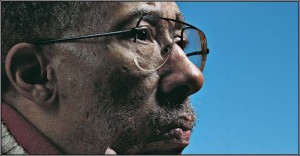
The African American Experience: Writers of Multicultural Fiction for Young Adults: Julius Lester
Black and Jewish, Searching For A Home (2011)
Lian Amaris’ “Daddy’s Black and Jewish” explores the impact her adoptive father, Julius Lester, has had on her identity.

Update your calendars. We DO have a holiday during the month Cheshvan!
SIGD CELEBRATION , SUNDAY NOVEMBER 3rd @1pm.St. Nicholas Park 135th Street HARLEM, NYC. Join the Beta Israel Community as we celebrate the SIGD Festival.
The National Holiday of the Ethiopian Jewish Sigd
The Knesset legislated the Sigd Law-2008, declaring the 29th of Heshvan as a national holiday. Sigd is a holiday of Ethiopian Jewry, the community named “Beta Israel.” The name of the holiday is derived from the Hebrew word for bowing or prostration, “sgida”.
Sigd is celebrated on the 29th of Heshvan – 50 days following Yom Kippur (similar to the holiday of Shavuot, celebrated 50 days after Passover), and the community rejoices for the renewal of the alliance between the people, God, and His Torah.
In Ethiopia, the community used to gather from all distant villages to celebrate communally. The day prior to the holiday was used for carrying out special prayers to welcome the following day and for washing their festive clothing. The Kes (spiritual leader) would prepare cow and sheep meat for the feast to be held to end the holiday, during which the community fasted.
The Sigd ceremony was held on a high mountain, considered to be pure due to its resemblance to Mt. Sinai on which Moses was given the Torah. Elder members of the community would climb up to the place of prayer and ensure its purity and strengthen its surrounding fence, in front of which they would prepare the area to place the Torah scroll. Early in the morning, the community would bathe in the river and gather at the prayer house. The Kes would then extract the Torah to the sounds of singing and cries of happiness and lead the crowd up the mountain. Some of those present would carry with them a rock symbolizing their surrender before God and as a sign of regret for their sins.
The ceremony opens with the Kes reading excerpts from the Bible, spoken in Ge’ez and translated to Amharic. The excerpts included: Receiving of the Ten Commandments at Mt. Sinai (Exodus, 19-20), Nehemiah’s ceremony for renewal of the alliance with those returning from the Babylonian exile (Nehemiah, 8-9), and excerpts from the books of Leviticus, Kings, Isaiah, Jeremiah, Daniel and Psalms. Furthermore, the Kes would pray and accompany their service with sermons and preaching.
During the ceremony the members of the community would kneel, bow and direct their hands at the sky. This was followed by an interval of trumpets, while saying: “As we have had the fortune to celebrate the holiday this year, we shall have the fortune to hold it in Jerusalem in the next year.” The prayers following these words expressed joy, comfort and their hope for the return to Zion and the building of Jerusalem. The participants would return to the prayer house in the afternoon to hold a festive meal, accompanied with songs and dance.
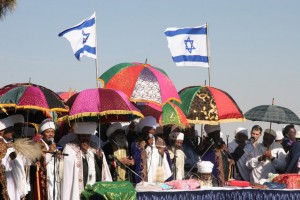
Ethiopian Sigd Festival – a religious worship in Jerusalem: Slideshow
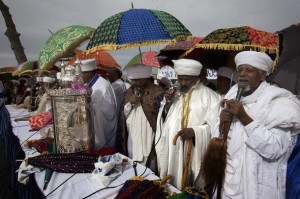
Today, as the majority of the Ethiopian Jewish community has made Aliyah to the State of Israel, members of the community make their way to Jerusalem, to the Wailing Wall and to the promenade at the “Armon Hanatziv” neighborhood in the city. The holiday serves as an annual gathering of the entire Ethiopian community and they see it as a chance to strengthen their affinity to their history and culture.
The Kessim carry the Bible holding colorful umbrellas. They stand on top of a stage to read the excerpts and prayers before the community. Many officials come and greet the audience, while the crowd continues to observe their fast until late in the afternoon.
Kol Nidre ~ All Vows
Audio CD: Good Night Dear Lord, Kol Nidre, Johnny Mathis
Kol Nidre: Ve’esarei, Ush’vuei, Vacharamei, Vekonamei, Vekinusei, Vechinuyei.
D’indarna, Ud’ishtabana, Ud’acharimna, Ud’assarna Al nafshatana
Miyom Kippurim zeh, ad Yom Kippurim haba aleinu letovah
Bechulhon Icharatna vehon, Kulhon yehon sharan
Sh’vikin sh’vitin, betelin umevutalin, lo sheririn v’lo kayamin
Nidrana lo nidrei, V’essarana lo essarei
Ush’vuatana lo shevuot.
All Vows, prohibitions, oaths, consecrations, vows that we may vow, swear, consecrate, or prohibit upon ourselves- from this Yom Kippur until the next Yom Kippur, may it come upon us for good – regarding them all, we regret them henceforth. They will all be permitted, abandoned, cancelled, null and void, without power and without standing. Our vows shall not be valid vows; our prohibitions shall not be valid prohibitions; and our oaths shall not be valid oaths.
Kol Nidrei, meaning “All Vows,” are the opening words of a declaration recited by the prayer leader in the synagogue at the commencement of the Yom Kippur evening service. It states that all kinds of vows made before God unwittingly or rashly during the year (and hence not fulfilled) shall be considered null and void. Kol Nidrei, a very old declaration, is recited in Aramaic is recited in most congregations three times, and in Aramaic. During its recitation the ark is opened and two Torah scrolls are removed, one held on each side of the prayer leader.
Kol Nidre has an interesting history. It was composed during the sixth century when the Visagoth king of Spain ordered Jews to convert on pain of death. Kol Nidre was initially the anguished cry of those forced to commit apostasy. Thereafter, Spanish Jews sang it when they gathered in secret to celebrate Yom Kippur, as they did in the ninth century under Byzantine persecution, and again during the papal and Spanish inquisitions of thirteenth and fifteenth centuries.
The intense emotion and spiritual energy that can be generated by a Yom Kippur eve Kol Nidrei service is demonstrated by the story of the German Jewish philosopher, Franz Rosenzweig (1886-1929). Franz Rosensweig was a young Jewish philosopher in Germany before WW I. In order to receive an appointment at one of Germany’s most prestigious Universities, Rosensweig decided he would convert to Christianity. Religion in general, and Judaism in particular, held little interest for him. It served only to impede his professional advancement.
As the story goes, he was out for a stroll on the eve of his conversion to Christianity when he passed by a synagogue. It was Erev Yom Kippur and as he passed by the synagogue, he could hear the chant of Kol Nidre. He was riveted to the spot, unable to move. By the time the cantor reached the prayer’s conclusion, Rosensweig knew in his heart that he could never leave Judaism.
Hear Musical Traditions from East to West.
Days of Awe: An Idelsohn Society High Holidays 2010 Mixtape, and the release of Black Sabbath, the first compilation ever to showcase legendary African-American artists singing Jewish songs.
Johnny Mathis discusses singing Kol Nidre
Kol Nidre~ All Vows
Link: Musical Traditions From East to West
Yom Kippur is the only fast day decreed in the Bible. Abstaining from the pleasure of food is meant to improve one’s ability to focus on repentance. The Yom Kippur fast is a 24-hour fast that begins before sunset on the evening before Yom Kippur and ends after nightfall on the day of Yom Kippur.
~ May You Have An Easy Fast ~
And when you’re ready to break your fast, here’s a recipe for a delicious treat. You’ll want to use this recipe over and over again.
KUGEL is a famous Jewish dish, made especially by the Ashkenazi Jews of Eastern Europe. The word is Yiddish for ball, but it is sometimes translated as pudding or casserole, and related to the German Gugelhupf. Evidence exists that the dish was made over 800 years ago, though it has gradually been modified and improved upon over time. Many are used to thinking of kugel as a dessert, and you will certainly find lots of kugel dessert recipes. It can also be made as an unsweet savory side dish or entrée using different types of cheeses, mushrooms, etc. Kugels are a mainstay of festive meals in Ashkenazi Jewish (Jews of Eastern European descent) homes, particularly on the Jewish Sabbath and other Jewish holidays.

Sweet “Light and Fluffy” Kugel
16 oz Wide Egg Noodles
2-8oz bars of cream cheese (room temperature)
1 cup sugar
1 pint sour cream
1 teaspoon cinnamon
2 teaspoons vanilla extract
1 teaspoon almond extract (optional-gives a slight marzipan flavor)
6 eggs
1 stick of butter, melted
1/2 cup raisins or my preference – golden raisins (optional)
Cook noodles following package instructions. Drain & set aside. In a (very) large bowl mix together all ingredients until cream cheese resembles cottage cheese. Add noodles. Mix well. Oil spray 9×13 inch pan or one of your choosing and pour in mixture. (Optional-sprinkle top lightly with cinnamon.) Bake @ 350 degrees F for at least one hour or until lightly golden brown and firm in the center.
I usually freeze 1/2 of the kugel for later use. I don’t know if it’s the same for you, but the last thing I need to do is gain additional pounds from nibbling on the luscious thing all week until it’s all gone. It can be prepared weeks in advance, baked, and frozen. It need not be thawed before going straight into a 350 degree oven for an hour. I recommend covering it with foil before re-heating it in the oven.
May all of us be listened to & embraced & welcomed & supported in the coming year!
Food For Thought: Differences Between Ashkenazi and Sephardi Rosh Hashanah Traditions
 ‘Girl with a Pomegranate’ by William-Adolphe Bouguereau (1825–1905) It’s that time again. Rosh Hashanah, like a smiling bride, tantalized our tongues with apples and honey, round challah with raisins, and hopes for a sweet new year.
‘Girl with a Pomegranate’ by William-Adolphe Bouguereau (1825–1905) It’s that time again. Rosh Hashanah, like a smiling bride, tantalized our tongues with apples and honey, round challah with raisins, and hopes for a sweet new year.
But did you know that not all Jews celebrate Rosh Hashanah this way? While apples and honey is an almost universal tradition these days, it stems from late medieval Ashkenazi roots. Likewise, the wellknown round challah, sweetened with raisins and dipped in honey, as well as lekach – Jewish honey cake – come to us fromthe Eastern European tradition.
Indeed, Israel is truly celebrated as the “Land of Milk and Honey” as Ashkenazim serve disk-shaped sweetened carrots cooked with sugar, raisins or prunes, reminiscent of gold coins.
As for the apple, according to the Vilna Gaon of 18th century Lithuania, it is to remind us of Jacob, who smelled like the field, in contrast to Esau’s blooddrenched odor, when he received his father Isaac’s blessing.
Honey drips with sweetness, pollinating new beginnings in contrast to salt’s sharp sting. Meanwhile, the second night of Rosh Hashanah greeted us with new fruit.
Pomegranates are not taken for granted either. These sweet grenades of flavor so yearned for by the Israelites when they wandered in the desert, promised by Moses to be returned to them when they made it to Eretz Yisrael, are truly savored by Sephardic Jews on this Holy Day.
The fruit’s crown is reminiscent of the Lord’s Kingship, while the seeds symbolize the Torah’s 613 mitzvot. This “grained apple” is thought by some to be the fruit in the Garden of Eden, while for others it conjures up poetic images from the Song of Songs of spiced wines and flowering orchards.
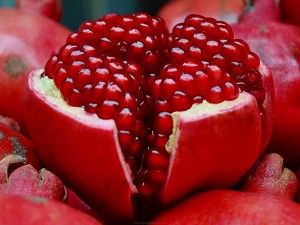 Just as this fruit is abundantly filled with seeds, so Sephardic Jews pray to Hashem that their lives might be filled with peace and prosperity, a bouquet of mitzvot garnishing their every day.
Just as this fruit is abundantly filled with seeds, so Sephardic Jews pray to Hashem that their lives might be filled with peace and prosperity, a bouquet of mitzvot garnishing their every day.
Sephardim, along with the Mizrachi Jews of the Middle East, practice a special mystical tradition – the Rosh Hashanah Seder, which according to some sources goes back more than 2,000 years. This Seder includes symbolic foods, many of which are based on puns or “signs.” Dates, green beans, pumpkins, leeks, beets, an apple compote called “mansanada,” and the head of a fish are presented alongside the pomegranate on a round dish, representing the wholeness of life.
Like many things in life, whether or not we do something often comes down to the weather. The main differences between traditional Ashkenazi dishes, coming from Russia and Eastern Europe, and those of Sephardi Jewry, with its Spanish, Italian and North African flavors, can be attributed to each culture’s differing climate.
Ashkenazi Jews contended with both poor agricultural conditions as well as a frigid climate, and so their more isolated shtetl existence became rooted in vegetables, poultry and simple meat dishes. The Rosh Hashanah meal thereby took on these hearty attributes, gefilte fish and kreplach – dumplings filled with meat or potatoes – consistently appearing on the dinner table.
In contrast, Sephardic cuisine is typically lighter, substituting rice or couscous for the starchy potatoes, partnered with fresh fruit. Also included are foods unknown to the Jews of Eastern Europe such as: spinach, artichokes, pine nuts, and squash. Jewish merchants traveled to the Iberian peninsula carrying with them unique spices from across the Mediterranean. Intoxicating aromas and exotic flavors, along with drizzling olive oil, combined to both soothe and stimulate the palate.
A typical Sephardic Rosh Hashanah Seder is replete with such foods, each representing the wishes and hopes of its participants in its own way.
Black-eyed peas and fenugreek are stewed with veal to make a dish known as lubiya. The Aramaic “ruvia” meaning “many” or “increasing,” celebrants hope that through prayer and consumption of these vegetables God will “increase their merits” in the coming year.
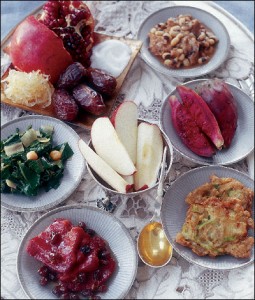 Moroccan couscous with seven vegetables is another often-found Seder dish. Each grain is said to represent a blessing or mitzvah, which they could hope to experience, while the number seven is considered good luck and recalls the cosmic act of Creation. Candied quinces are eaten alongside the Shehecheyanu prayer in Morocco.
Moroccan couscous with seven vegetables is another often-found Seder dish. Each grain is said to represent a blessing or mitzvah, which they could hope to experience, while the number seven is considered good luck and recalls the cosmic act of Creation. Candied quinces are eaten alongside the Shehecheyanu prayer in Morocco.
Sephardim also eat leeks, beets and dates, each of which carries its own mystical meaning. Meanwhile, the head of a fish is often used as a substitute for the ancient tradition of presenting a baked ram’s head on the dinner table – a reminder of Abraham’s sacrifice of a ram rather than his first-born son.
The fish’s head represents the desire that we may be leaders not followers, “the head and not the tail.” Fish have a long history of being considered a good symbol in the Jewish tradition, representing fertility as well as prosperity. Also, as fish do not sleep, likewise we are to be “constantly awake” in our desire to be holy.
Some Sephardim, however, avoid fish, thinking it fishy that the Hebrew word “dag” sounds an awful lot like “daagah,” meaning to worry, hoping to minimize their chances of having to worry about worries in the coming new year.
Nuts – “egoz”– are also to be avoided, not because they are lacking, nor for some other egoistic purpose, but rather because the gematria i.e. the numerical value of the Hebrew letters, is similar to that of “chet”- the Hebrew word for “sin.”
Surely, it would be sinful to single out only one such food to avoid, and so we see that some Sephardim also do away with honey. Instead, they dip their traditional flatbread into sugar. The reason? Honey was thought to make the incense in the Temple “impure.”
Today, one may experience dishes such as leek patties, whitefish salad, and pumpkin turnovers, all of which display their Sephardic heritage, while modern-oriented Ashkenazim can enjoy carrot and apple soup, teriyaki salmon, or a decadent slice of honey cheesecake. Kosher creations from roasted lamb to home-made baked beans, red cabbage salad, and fresh figs ensure the holiday to be a truly festive occasion.
Tapuchim u’dvash*
A sweet treat we love to eat
To start a new year
“May it be Your Will That Our Merits Increase Like The Black-Eyed Peas.”
1/2 pound dried black-eyed peas, or 3-4 cups frozen black-eyed peas cooked according to directions on package
5 cups water 1 tablespoon tomato paste
3/4 teaspoon ground coriander
1/2 teaspoon ground cumin
1/2 teaspoon paprika salt and pepper and cayenne pepper
1 tablespoon olive oil
1 large chopped onion
2 tablespoons chopped cilantro
To prepare the peas: pick them over, getting rid of any pebbles and broken or discolored peas. Soak them 8 hours or overnight in water to cover; or put them in a saucepan with a quart of water, bring to boil, boil uncovered 2 minutes, remove from heat, cover and let stand one hour. Drain and rinse the peas. Put them into a medium saucepan and add the water. Bring to a simmer, cover, and cook about 1 1/2 hours (or until tender) over low heat. Drain the peas, reserving 1/4 cup cooking liquid. (I’d reserve more to be on the safe side; this doesn’t seem like enough to me.) Put drained peas into a medium saucepan. Mix the reserved cooking liquid with the tomato paste and add it to the pot. Add the coriander, cumin, paprika, salt, pepper and cayenne pepper. Bring to a simmer and remove from heat. In a heavy skillet, heat the olive oil, add the onion, and saute over medium head, stirring often, about five minutes. (She uses a non-stick skillet; you might need more oil with a regular skillet.) When the onion begins to brown, add a tablespoon of water and saute until the onion is deeply browned. Then add the onion to the pea pot, cover, and gently heat for five minutes. Add half the cilantro. Taste and adjust seasoning. Serve it sprinkled with the other half the cilantro. Beth Greenfeld.
Rosh Hashanah Egyptian Black-Eyed Peas by Diane Kaufman-Tobin
Ingredients:
1 onion, chopped
3 tablespoons sunflower oil
2 garlic cloves, minced or crushed in a press
1.5 lb (750g) lamb or veal, cubed (optional)
1 lb (500g) tomatoes, peeled and chopped
3 tablespoons tomato paste
1 lb (500g) dried black-eyed peas, soaked for 1 hour
1 teaspoon cinnamon
1/2 teaspoon allspice
Salt and pepper
1-2 teaspoons sugar
Directions:
Fry the onion in the oil till golden. Add the garlic, and when aroma rises add the meat. Stir to brown it all over. Add the tomatoes and tomato paste. Drain the black-eyed peas, and simmer on fresh water for 15 minutes, then drain and add them to the meat. Add cinnamon and allspice and cook for 2 hours, adding salt and pepper to taste and the sugar after about 1 hour.
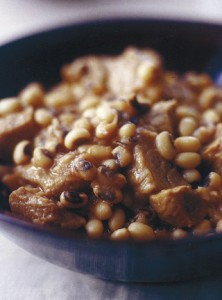
Quentin Bacon, Photographer:
New Year’s Table: A tradition for Syrian Jews and those from the American South. Recipes: ‘Aromas of Aleppo’
At Rosh Hashanah, Black-eyed Peas for Good Fortune
A Google search linking black-eyed peas and Jews reveals a wide discussion about the Jewish roots of the popular hip-hop band (sadly, none) and a riff on Lenny Bruce’s Jewish vs. goyish shtick that peas are Jewish while black-eyed ones are goyish.
But black-eyed peas are Jewish. Jews from both Syria and the American South eat them as part of a celebratory meal on Rosh Hashanah.
One tradition dates back to a 2,500-year-old text and the other crops up in the mid 20th century. Could the two be connected?
The peas — actually beans from the cowpea family — are white with a small black circle, or “eye,” near the base. Indigenous to West Africa, Ethiopia or the Far East (depending on your source), they made their way to Judea at least 500 years before the Common Era and were brought to America by slaves in the 17th century. When cooked alone they are relatively bland; however, being easy to grow and high in protein and carbohydrates makes them an inexpensive staple in Southern states and in the Middle East, though not much of a holiday treat.
Poopa Dweck, author of “Aromas of Aleppo” (HarperCollins, 2007), explains in her book that Syrian Jewish families begin the New Year with a Seder, a ceremony before a Rosh Hashanah meal. “The foods of the New Year holiday symbolize a wish for a sweet year. Aleppian Jews eat several symbolic foods during the Rosh Hashanah dinner… that correspond to the wishes of the Jewish people for the coming year,” she writes.
The tradition comes from the Babylonian Talmud, which states, “Abaye said, ‘Now that you have said that an omen is significant, at the beginning of each year, each person should accustom himself to eat gourds, black-eyed peas, fenugreek….” Each of the foods (nine in total) represents something different for the year ahead; the black-eyed peas symbolize good fortune. For a Syrian meal, they’re traditionally prepared in a simple recipe with garlic, onions and veal. The dish can be spiced up with cinnamon and allspice or flavored with tomatoes or tomato paste.
The dish symbolizes prosperity in ways: A single serving contains so many of the small beans and the dish’s name pays homage to abundance. Black-eyed peas are rubiyah (in Aramaic and Hebrew) or lubiya (in Arabic), which are cognates of the Hebrew words harbeh, meaning many, and l’harabot, to increase. The idea is to take in prosperity at the start of the year, with the hope that it will serve as a good omen for the year ahead. While the Syrian Jewish community is the only one to eat the beans in a Seder Rosh Hashanah, other Sephardic communities have adopted the tradition of the Rosh Hashanah beans.
This culinary tradition likely arrived in America with Sephardic Jews who moved to the South in the 18th century. Many Jews of the South had black cooks, who prepared a combination of what their Jewish owners or bosses requested and dishes from their own culinary traditions. In the case of black-eyed peas, those traditions overlapped, both groups having their own preparations of the beans. Though the two black-eyed pea traditions intersected in the early South, they didn’t meld into one; nor did one seem to rub off on the other.
Around the same time, the tradition of eating black-eyed peas January 1, still widely popular in the American South, was crystallizing in the surrounding non-Jewish communities. Hoppin’ John, a dish made with black-eyed peas, rice and pork, is eaten to obtain a prosperous year. It’s served in a meal alongside greens whose leaves symbolize paper money, thus wealth.
The sources of both the dish’s name and its symbolism have become the province of legend and lore. Some argue that the beans represent coins, while others argue that because they expand while cooking, they represent abundance. Southern food historian John Taylor explains that the combination of rice and beans in the dish came “with the enslaved” from Africa, while the tradition of eating them on “New Year’s probably came from the Caribbean, where they prepare a similar dish called Moros y Cristianos (Moors and Christians).”
The first recipe on record for the dish in the South is in “The Carolina Housewife,” from 1847, one of the nation’s earliest cookbooks. It’s likely, however, that the dish was prepared much earlier, particularly since its roots are in slave culinary traditions, which were maintained orally. Over time, the dish was adopted by white Southerners for whom the slaves cooked, and was incorporated into the greater Southern culinary canon, particularly of the low country in the Carolinas and parts of Virginia and Georgia.
More than 150 years later, the dish not only appears in households on secular New Year’s Day, but also in kosher variations on tables of Jewish families in the South celebrating the Jewish New Year. Jewish recipes (found in Sisterhood cookbooks from the South) often replace the pork with a smoked turkey leg, but there are also vegetarian preparations.
Marcie Cohen Ferris, author of “Matzoh Ball Gumbo” (University of North Carolina Press, 2005), explains that the tradition started in the 1960s: “On holidays, people cook traditionally, but there’s a group of people who like to add in regional flavors to give it a signature of place. What could be more of a symbolic dish than to grab that dish from the secular New Year’s and claim it for Rosh Hashanah?”
Ironically, it is by adopting this African-Caribbean-Southern-Christian tradition (possibly inflected by local Sephardim) that the Jews of the South are reclaiming and reconnecting to a Jewish tradition that dates back more than 2,000 years. by DevraFerst, The Jewish Daily Forward
L’shanah Tovah Tikatev V’taihatem!
May you be inscribed and sealed for a good year!
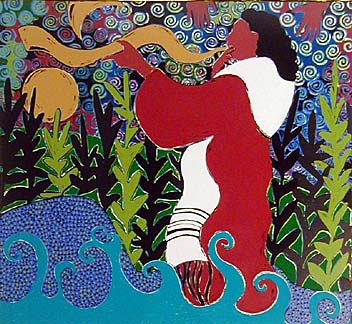 Artist: Lynn Feldman ~ Serigraph: She Blew the Shofar
Artist: Lynn Feldman ~ Serigraph: She Blew the Shofar
